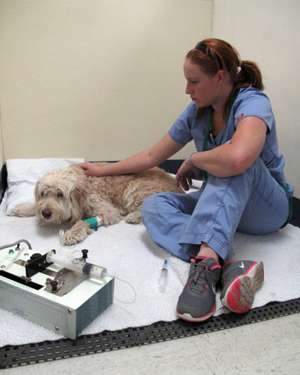
Medical treatment utilizes non-surgical methods to manage a patient with, or recovering from, a neurological disorder. Administration of pharmaceuticals and providing proper patient care can slow down or reverse the disease process. When a patient undergoes surgery, medical treatment is always utilized before, during and after the procedure.
Pharmaceutical Therapy
Patients are treated with pharmaceuticals for a variety of medical reasons. They may be used to induce and maintain patients under anesthesia, fight infections, reduce pain and inflammation or suppress an overly active immune system. In neurology, pharmaceutical therapy may be the primary source of treatment to control certain disorders such as myasthenia gravis, meningitis and epilepsy. They may also be used to replace deficiencies of fluids, vitamins, minerals and nutrients in the system. In emergency situations pharmaceuticals can be administered to treatarrythmias, bradychardia and shock.
Seizure Control
Patients who are seizing are often given intravenous diazepam (Valium), an anticonvulsant, to stop the seizure. Seizures can be very debilitating to the entire body. It is important to stop them as soon as possible. Patients with severe and/or an abundance of seizures should be hospitalized because they may become incapacitated and unable to eat, drink or control urination and defecation. The condition of rapidly recurring seizures without recovery between episodes is called status epilepticus. It is immediately life-threatening and can cause hyperthermia, respiratory compromise and permanent brain damage. The neurologist may recommend diagnostic testing to determine the cause of the seizures. If diagnosed with epilepsy, patients often will continue much, if not all, of their lives with seizure tendencies. Epileptic patients will likely need to be maintained on anticonvulsant medications such as phenobarbital, potassium bromide and zonisamide to prevent the severity and frequency of seizures.
Patient Care (hospitalization)
Patients with neurological disease may require medical treatment and close observation in a controlled environment to ensure they are responding properly to treatment. Patients hospitalized at the Veterinary Neurological Center are treated on-site by one of the staff neurologists and veterinary technicians during routine business hours, and specially trained caretakers monitor the patients overnight and on weekends. The neurologists sometimes recommend that a patient with severe systemic disease be hospitalized at an emergency clinic, where an on-site doctor is available to monitor and treat the patient throughout the night.
Patients with paraplegia or tetraplegia need intensive nursing care. The patient should be maintained on padding and turned every 4-6 hours to avoid decubital ulcers (bedsores). The skin must be kept clean and free of urine and feces to prevent dermatitis. The bladder must be expressed or catheterized every 6-8 hours and the urine monitored for evidence of cystitis. Tetraplegic patients may need to be hand fed nutritious food and offered plenty of water. Manual extension and flexion of joints and muscle massage will help delay contractures and muscle atrophy in paralyzed limbs. Once a patient’s condition has stabilized, the neurologists will recommend a manageable treatment plan that the owner can follow at home.
Patient Care (at home)
The type of home care that a patient requires may be relatively simple (e.g., administering an oral pharmaceutical during the day) or somewhat complex (e.g., catheterizing a pet’s bladder, administering different pharmaceuticals several times a day) depending on the nature and severity of the neurological disease. In either case, a well designed treatment plan will provide the client with the information necessary to help their pet’s health improve. Carefully following this plan (e.g., administering medications according to directions) will help the veterinarian make treatment adjustments as the patient’s condition changes. Prior to a patient leaving the Veterinary Neurological Center, each client will meet with the doctor to answer questions and discuss the Discharge Summary. The report summarizes information about the patient’s problem, diagnostic testing results, the treatment plan and future prognosis. The referring veterinarian will receive a similar report, the Referral Summary. It is important that the owners and referring veterinarian continue to consult with the Veterinary Neurological Center when necessary to ensure that the patient is progressing according to the treatment plan. Although the neurologist may be unavailable to speak directly with the client at times, the experienced front office client service representatives will relay medical questions to the neurologist and promptly provide the client with the doctor’s response.
This information is meant to be a guide and not a substitute for veterinary care.
Always follow the instructions provided by your veterinarian.
